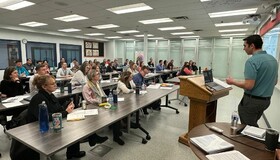Supporting students with complex needs

How the Collaborative Problem Solving model is helping students with challenging behavior or complex needs
A principal recently received professional learning that was so powerful he chose to bring the opportunity to his staff and to other Chinook’s Edge colleagues.
Chris Adamson, Principal of Innisfail High School, was so impressed with the Collaborative Problem Solving model that was being shared in Chinook’s Edge, that he signed up for more in depth training. After that was complete, he invited the trainer to the school to work with some of his staff one day last week, as well as other colleagues in Chinook’s Edge (represented in the photo).
The division is working to employ the Collaborative Problem Solving model in its schools to support students with challenging behaviour or complex needs. The number of students with complex needs has increased in recent years.
“This approach is powerful because it assumes that students will meet expectations for behavior if they can. It is an empathetic way of engaging with students that gives adults confidence and calm,” said Adamson.
It empowers adults to focus on helping students build the skills they need to be successful,” said Adamson.
Marcie Perdue, Associate Superintendent, Chinook’s Edge School Division says this approach is currently used by the Alberta Children’s Hospital when supporting children with complex needs. The approach challenges conventional societal wisdom that students who don’t meet expectations lack the will to make a better choice.
“The Collaborative Problem Solving model creates an opportunity for a shift in the mindset of adults working with children,” said Perdue. “When a child doesn’t meet behavioral expectations, instead of thinking about that as a choice the student is making, what is more helpful is considering what cognitive skills a child may be lacking. When students don’t meet expectations they are most likely lacking skill rather than will.”
Karyn Barber, Associate Superintendent, attended last week’s session at Innisfail High, and said, “One aspect of the model that impresses me is the opportunity to give students voice in solving issues. It involves them in helping to find solutions, and supports students as they develop social emotional skills. We anticipate the great benefit this will be for students, and that as they find social emotional success they will also find academic success.”


